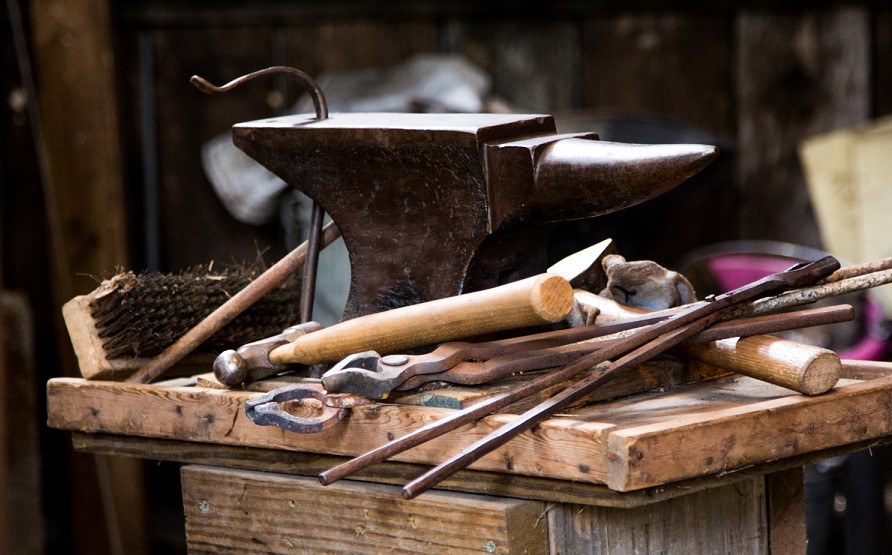Blacksmithing is the art of shaping and forming hot metal into a variety of objects. It involves working with tools such as hammers, tongs, anvils, and forges to create items from cast iron and other metals. A blacksmith needs to have a set of essential tools to properly practice their craft.
In this article, we will talk about all these tools, and give some detailed information about them.
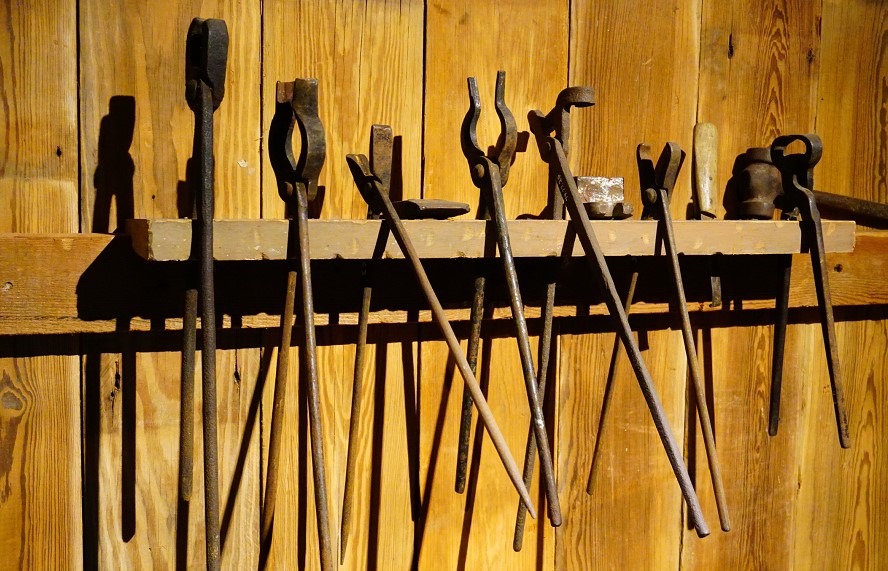
Contents
Essential blacksmithing tools list
The blacksmithing projects that a blacksmith can work on are endless – from making small tools to large sculptures. Each project is unique and requires special attention to detail.
The blacksmithing process involves heating metal in a forge, shaping it with various tools, and then applying a finish or protective coating.
Blacksmiths must also consider safety when working with hot metals as well as proper storage for their finished products.
In this article, we will discuss some of the most common blacksmithing tools and their uses. We will also provide a list of basic blacksmithing tools that are necessary for any beginner blacksmith.
With the right set of tools, you can begin your journey into the world of blacksmithing and create beautiful pieces from hot metal.
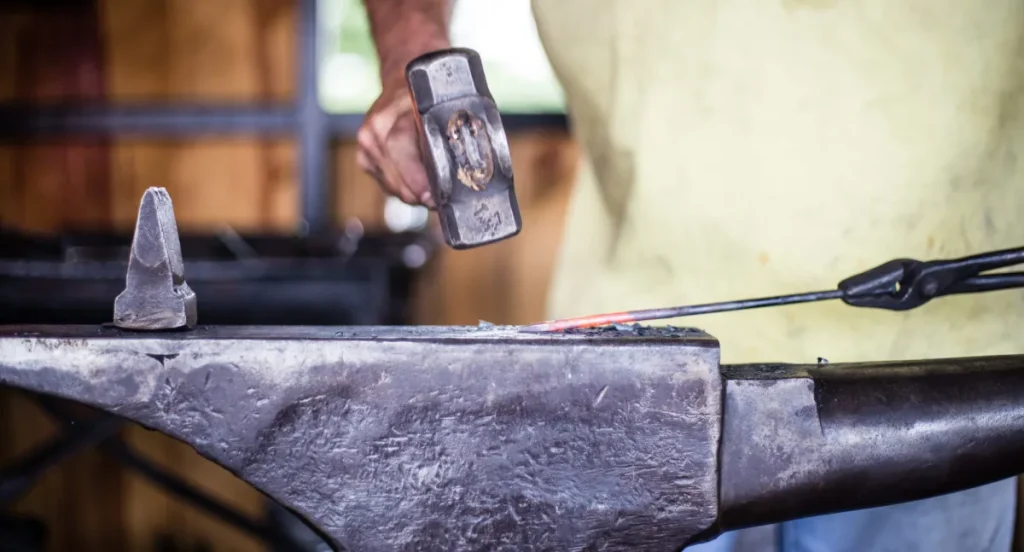
Essential blacksmith tools that every blacksmith uses
Below we listed the crucial blacksmithing equipment, and blacksmith tools names required for the blacksmith profession.
Anvils
Used to shape hot metal and create holes in it. They come in a variety of shapes, and they can be made from steel, iron, and other materials.
The anvil is the backbone of the blacksmith. It’s the symbol.
Wherever there is a blacksmith, there is also an anvil. It’s used to withstand the blows and strikes to the object you working on. Essentially it’s a big block of steel or cast iron.
Anvil horn
These are used to shape the metal by hammering on them. They usually have a flat top for working with round objects and a flat bottom for working with square objects and round stock.
Bending forks
These are used for bending bars or wire into desired shapes. They come in various sizes depending on the type of bend needed.
If working with a single vertical Bick seems challenging, this bending fork comes with a design similar to that of a tuning fork. It offers great value when it comes to the bending and shaping of materials.
All bending forks have two positively charged vertical poles with a thickness comparable to that of the workpiece. It can be made to fit in the Hardie hole for a strong base.
The vertical poles help in keeping the stock bar steady during the hammering process. You can quickly get the desired bends.
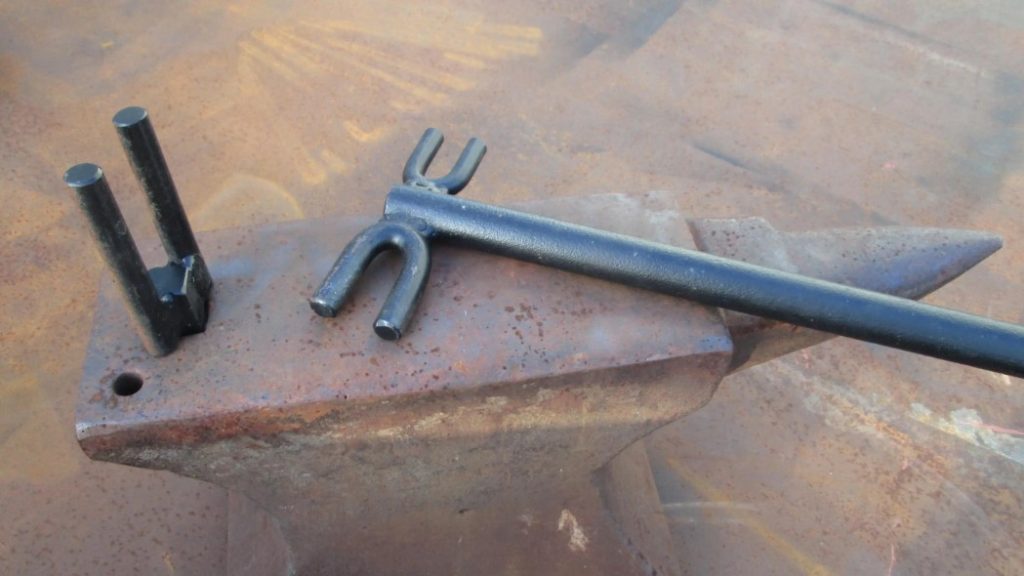
Flat surface
The flat surface is used for flattening out uneven areas on flat pieces of metal before bending them into an arbitrary shape with another tool like a vise grip plier. You can also use it to mark out certain areas.
Coal forges
These blacksmithing tools are used for heating metal to over 1,000 degrees Fahrenheit so that it can be worked with without damage being done to itself or other parts of its surroundings (which would result in an explosion).
If you want to learn how to make your own blacksmithing tools or get started in the trade of blacksmithing, there are plenty of options available. Here are the basics:
Marking tools
These blacksmith tools are used to mark the metal before it is shaped into whatever shape you want.
They can be used with pneumatic or hydraulic presses to create holes or slots in metal objects such as gears, knives, and various parts of electrical equipment.

Cold cutting tools
These blacksmith tools are used to cut through hardened steel without heating them too much; they do this by using cold water or oil to cool the metal down so that it becomes soft enough for cutting purposes.
Cold cuts can also be done using an electric arc furnace or gas forge, which works by heating the metal until it becomes soft enough for cutting purposes.
Tong
Tongs are used to hold and manipulate objects. Tongs can be made from any material, but are usually made of metal or wood.
Tongs that are made of metal are often called “steel” tongs, while those made of wood are usually called “firmer.”
Round tongs are used to hold round objects while they’re being manipulated.
They have a small flat head that allows them to be used with precision on smaller round objects, such as nuts, bolts, and screws. Round tongs are also known as socket wrenches.
Hammer tongs are designed to hold and manipulate objects in an angled position. They have a long handle which allows users to hold larger metal objects easily without needing to use both hands at once.
Hammer tongs often come with rubber pads on the end so that they won’t mar surfaces when used on them.
Chisel
A chisel with a round nose is ideal for this job, as it will not leave any sharp edges on the surface of your workpiece.
You will also want to make sure that your chisel is at least 1/8 inch in diameter so that it can penetrate through the thickness of your piece easily.
Once you have your chisel, you can use different types of hammers to ensure that you get an even finish on all sides of your workpiece.
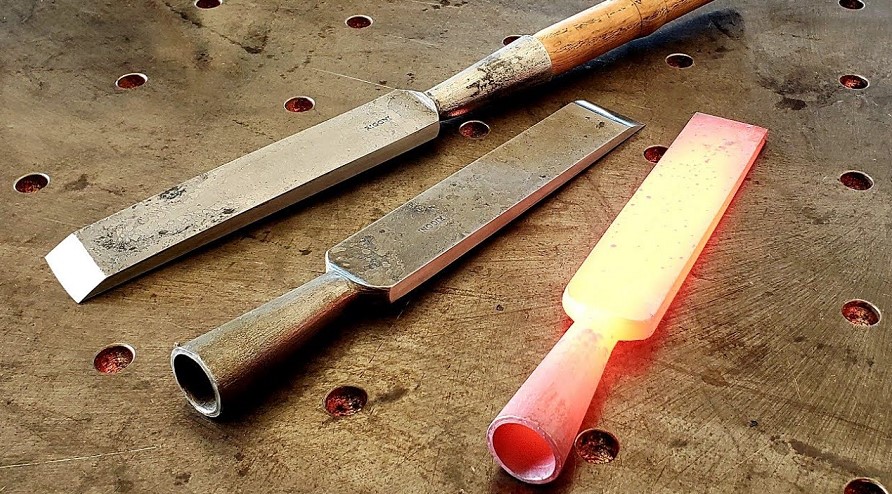
Chisel plate
This tool is placed on top of an object to be worked on so that it can be hammered away from its surface without damaging it.
This type of plate is often used when working with metals like iron or steel because they have little mass and require less force than something like wood would require when struck by a hammer blow intended to remove material from its surface
Monkey tool
This is a soldering tool that can create a square tenon for something to sit on. Some blacksmiths use it for rose stems, but you can use it wherever you require a tenon.
The build is simple—a metal stock having a hole that is proportional to the tenon to be shouldered. The hot bar stock is fixed in a vise, and this tool is hammered onto the tenon.
Hardy tool
Hardy tools are steam-powered drop hammers that allow you to work the metal without needing to build a fire. With hardy tools, you can forge your own tools, repair broken ones and even create new ones.
The best place to learn how to use these blacksmith tools is in a blacksmithing shop. These shops are usually run by an experienced blacksmith who will teach you the basics of working with metal.
For beginner blacksmiths, who want to become an expert blacksmiths, it’s best not to do it alone—you’ll need someone else who knows what they’re doing around the shop, to acquire all the essential blacksmithing skills.
This person should be able to help you work through any problems that come up during an experiment or when something goes wrong during an actual forge session.
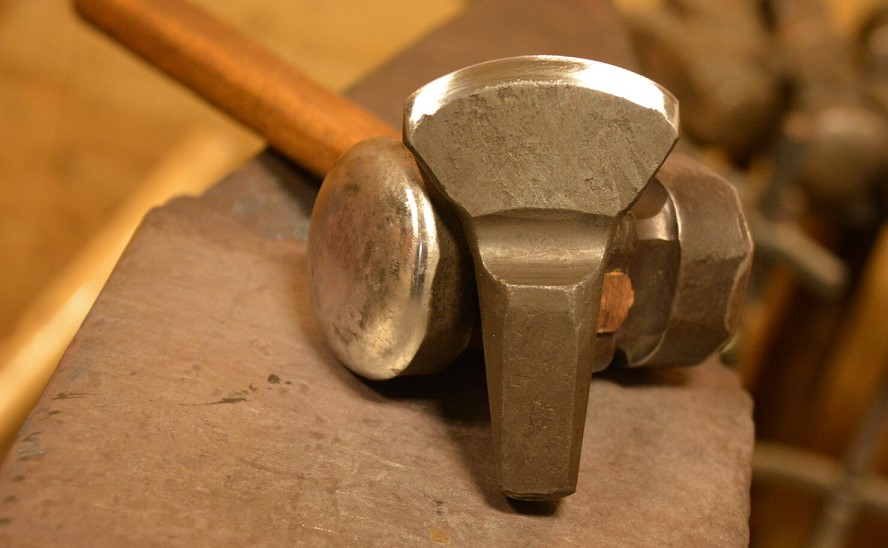
Rivet bucking Hardy (Rivet Header)
Rivet Header is a simple piece of metal having a cylindrical shape. It is useful in joining two bars together or forging tools like tongs etc. It complements the work of other blacksmith tools.
The rivet header should have a depression that matches the head of the rivet. You can have “heads” of different shapes like dome, conical, or pyramid.
Hot cut Hardie
Hot Cut Hardie (Chisel) is an essential tool for blacksmithing projects. It is used in the trade of blacksmithing to shape and form metal into various shapes and sizes.
This tool has been around for centuries, but modern-day versions are more efficient and easier to use. Hot Cut Hardie (Chisel) is used during the process of blacksmithing to cut, trim, and shape metal pieces into desired shapes.
As evident from the name of this blacksmith tool, they are used to cut hot metal bars. Hence, it is safe to say a chisel is a hardy tool.
With its sharp cutting edge, it allows blacksmiths to create intricate designs with ease. Hot Cut Hardie (Chisel) is a versatile tool that can be used for a variety of projects such as furniture making, jewelry making, decorative items, and more.
Hot-cut Hardie is thinner and longer compared to a cold metal chisel.
Col cut Hardie
Cold Cut Hardie (Chisel) is a blacksmithing tool that has been around for centuries. It is used to cut cold metal and shape it into the wanted shape. It is an essential tool for blacksmiths, as it helps them create beautiful and intricate pieces of art from metal.
The Cold Cut Hardie (Chisel) requires special skills and techniques to use, which only experienced blacksmiths possess.
With the help of this tool, they can create intricate designs on metal surfaces that are not possible with any other tools.
This makes Cold Cut Hardie (Chisel) an indispensable part of any blacksmith’s toolbox.
Punches
Punches are an essential tool used by blacksmiths in the blacksmithing trade. They are used to make holes and indentations in metal objects, and they come in a variety of shapes and sizes.
Blacksmiths must have a good understanding of how to use punches correctly if they want to produce quality work.
Punches can be used for both decorative and functional purposes, so having the right skills is important for any aspiring blacksmith. With the right tools and skills, blacksmiths can create beautiful pieces with punches that will last for generations.
Drift
If you require larger holes, you’ll have to use a drift. Being manufactured from carbon-tool steel, they can go through any stubborn metal.
Drifts are similar to punches but the former is useful for more complicated tasks. Sometimes, it is also essential to complement the work of punches.
A punch is used to make an initial hole, and the drift makes that hole larger and more precise. From round to square, drifts come in all shapes and sizes.
Vise
A metalworking vise (known in the UK as a metalworking vice or engineer’s vice) is a mechanical apparatus used to secure an object to allow work to be performed on it.
Vises have two parallel jaws, one fixed and the other movable, threaded in and out by a screw and lever.
Woodworking vises are attached to a workbench, typically flush with its work surface; their jaws are made of wood or metal, the latter usually faced with wood, called cheeks, to avoid marring the work.
This tool is a must-have for any blacksmithing shop. Buying one can be a big expense at first, but it’s well worth the money.
A good vise will last for years, so it should be one of your first purchases when you’re setting up your shop.
If you want to do amazing work as a blacksmith, investing in a vise is one of the best ways to ensure your success.
Post vise
A post vise is a tool that is used in forging. It has a plain surface that faces the anvil, and a movable jaw on one side that engages with the workpiece. The workpiece rests on this jaw while the anvil acts as a support for the workpiece being worked.
The purpose of this tool is to hold objects in place while they are being forged so that they can be heated up and shaped into their final form.
A post vise has two parts: the handle and the jaw. The handle is what you grip onto when using the post vise; it contains all of the moving parts within its body.
It also has a solid base that stays stable during use, allowing it to rest against whatever surfaces will be supporting your workpiece during forging.
The jaw is made up of a series of levers (or bowstrings) inside its body which allow it to move back and forth along its central axis while holding your workpiece steady at all times.
Fuller
Fullers are a type of hammering tool used in blacksmithing. They are used to create the final shape of metal and can be used on both flat and curved surfaces.
The fullers create a groove for the weld (or brazing) process. Fullers are typically made out of steel, but can also be made out of stainless steel, titanium, or even aluminum.
A fuller is typically used when creating a piece of metal that will have one continuous edge, such as an anvil or hammerhead.
It can also be used when creating pieces with multiple parts, such as anvils and hammers.
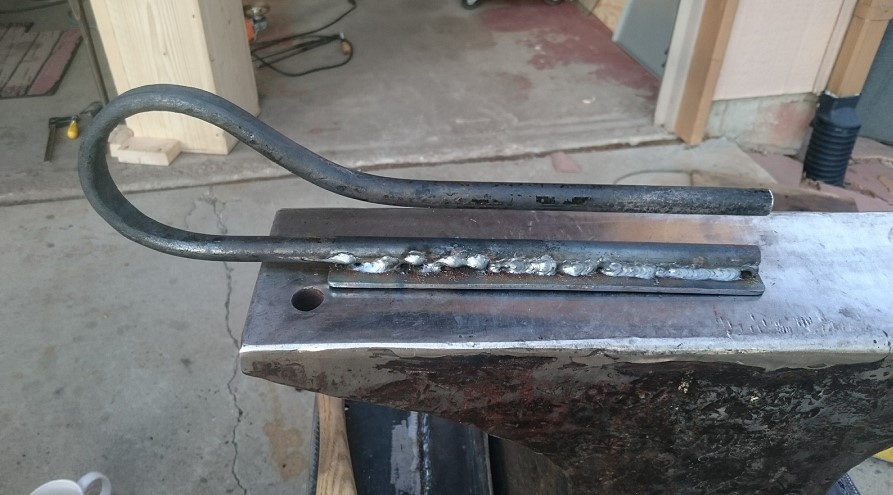
Top Fuller
It serves the same purpose as the tool mentioned above. Top Fuller can be used to groove or stretch the metal when it is hot. The main difference between them is the use of handles in the Top Fuller instead of the shank.
You just have to bang the top of the fuller. This tool comes in different shapes and sizes.
Blacksmithing hammers
In this part, we will talk about other blacksmith tools, especially – blacksmithing hammers.
Blacksmith hammers fall into two categories: pein and ring-shaped.
A pein hammer has an outer edge that is square or rectangular, whereas a ring-shaped hammer has a curved edge instead.
Ring-shaped hammers tend to be smaller and lighter than other hammers, but they’re also less flexible than their larger cousins.
If you want to create something like a bowl or square object, you’ll need to use a ring-shaped tool—but only if it’s made out of mild steel (which is easy to work with).
If the objects you want are made of harder metals like copper or aluminum, you’ll need to use another hammer instead.
Clipping hammer
A clipping hammer is a tool used to remove metal from a surface by striking it with a hammer. It has an anvil-like head and jaws that grip the workpiece and allow it to be struck repeatedly.
This term refers to a hammer with a round head.
A round head has no plain surface on the bottom, and it’s often used for driving nails into wood.
This type of hammer is typically used for smaller jobs such as driving in screws or drilling holes.
Ball pein hammer
A hammer with a round head, made of steel or iron, which has been rounded at one edge so that when struck against an anvil or other hard surface, it forms a ball-like impression on the surface of the material being worked on.
The shape of this type of hammer can vary depending on how much force is applied to it during use and how long it is held against whatever is being struck with it.
Rounding hammer
This hammer is an essential blacksmithing tool used to shape and curve metal into desired shapes. It is used to round off corners, create curves, and smooth out surfaces of the metal.
The hammerhead is usually made from hardened steel that has been heat-treated for durability and strength. The handle of the hammer is usually made from wood or plastic for comfort and grip.
With its curved face, the rounding hammer allows blacksmiths to make precise bends in the metal without damaging it. It can be used for a variety of tasks such as forging, riveting, punching, bending, shaping, and more.
Cross pein hammer
This hammer is a versatile tool that can be used for hot metal or cold hammering. It is typically made of bronze, although it can also be made from steel or other metals.
Used to shape metal into different objects—like creating holes in sheet metal or removing excess material from a piece of iron.
It also works well when beating out welds on larger pieces of metal so they do not stick together under pressure from another tool or hammer.
Cross peen hammer
Used for shaping metal into different objects—like creating holes in sheet metal or removing excess material from a piece of iron. It also works well when beating out welds on larger pieces of metal so they don’t stick together under pressure from another tool or hammer.
Trip Hammers
These hammers are used for shaping pieces of metal into desired shape shapes such as rings and bowls-shaped objects (such as coffee mugs).
To create a variety of different shapes on metal, blacksmiths use a wide range of tools. They start with a pein hammer and end up with an electro-hydraulic machine that can cut out holes in the shape of your choosing.

Frequently Asked Question
What are some tools that blacksmiths use?
The main tools that blacksmiths use are hammers, tongs, anvils, and forges.
What is the first thing a beginner blacksmith should make?
Beginner blacksmiths should first learn the basics of pounding and hammering.
Conclusion
In conclusion, of our review of different blacksmithing tools, we want to say that we hope that all this information was interesting for you and helped you to get more familiar with the blacksmith craft if you are a beginner in this.

